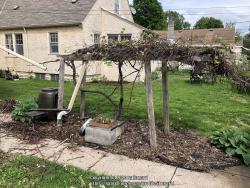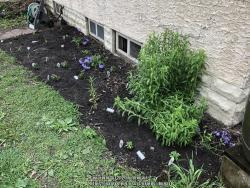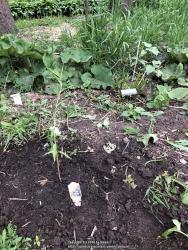Considerations after Blogging a Short While
I find I often want to talk about something that isn't related to the current garden activities in which I'm engaged. To that end, I think I'll finish every post with a "What Happened Since Last Time" section, in order to address whatever progress occurred, or any notable activities. I should probably try a "What's Next" section, too, to indicate my intended next activities.
I don't know if other people do this, but I've been creating blog posts as reminders of things I want to talk about, and then saving them, unpublished. So I have a store of ideas around that I can expand on later.
Something I Omitted from the Master List
So, when I published my Master Plant List, I neglected to include an important set of plants. These are essential plants, but I didn't have them in the list because they fulfill a different purpose than attracting the Minnesota-native bird-and-pollinator attractors.
Cooking herbs.
There are a number of herbs I like to have fresh. Here are the ones I will have this year:


First Things First: What Got Done
Since my last post, I finished clearing the East bed. Here it was before I started:

You can see the garden hose reel at the far end, and the New England Aster on the right side. That light yellow thing is an old metal lawn chair which had its tubular legs fold over. We have to take it to metal recycling.
But the key thing is that there wasn't anything special planted there. The white flags are part of a one-yard grid I put in place so I could map out planting areas and such for my original set of plants. In fact, you can see some of the newly-purchased plants in the lower-right of the image.
Here's how this area looked yesterday, after I cleared out all the weeds over the past couple of weeks:

This is from a different angle. The hose reel is cut-off on the left edge. The New England Aster is still on the right side; this is new growth from 2020, with the dead 2019 stems pruned away. I hadn't graded the soil, yet, but I was essentially ready to buy plants for this bed.
And this is how it looks today:

The plants are in place, and I've put the metal markers out. Some of the plastic ones I kept next to the plants, but the squirrels like to dig them up. I will probably end up doing one metal marker per plant, so I have no confusion next spring about which new growths are my perennials.
But...I got it done. And I have to say, it felt really good to have the bed all ready when I went shopping for plants. I was sorely tempted when I saw other plants on my list for the future, but I was good, and only bought what I was ready to put in the ground. The only exception was another Swamp Milkweed, because I had that area by my existing one:

I have to do some serious weeding in this area, but it was practically open where I put the new plant.
So, let's talk about how I decided what to put in here.
The Master List
Remember my goal: to put in native plants to attract wildlife to my yard. To keep birds and pollinators coming to the yard means having plants which bloom throughout the season. In Minnesota, that could be as early as March, and as late as October. I didn't have any plants which bloom in the early spring, to provide overlap with the plants which bloom in late May or early June. I need to fill that gap.
Another thing I want to do is plant all around my house, even the north side, which doesn't get direct sunlight. So I need to find more shade-loving plants that can occupy those spaces. As it happens, many of the spring ephemerals in Minnesota grow on forest floors in the shade, so I will likely be able to attract more early-spring pollinators and fill the shady spots.
Also, I want to provide more hummingbird-attracting plants. I had two species last year. The Large-Flowered Beardtongue, penstemon grandiflorus, didn't seem to do much beyond one stem and a couple of flowers; I'm not even sure if it will grow back this year, yet. I also planted four Wild Bergamot plants, monarda fistulosa, but they were so small last year that they didn't do much. They are much bigger so far than they ever were last year, so we'll see if they bloom.
I spent some time reviewing my books, handouts from the local bird-feeding store, and e-mail exchanges with my native-plant-savvy neighbor, and came up with a list of plants to get. Here we go...
Wow! I have Subscribers!
I just what to say THANK YOU to those of you who subscribed to my blog! That was totally unexpected. I'm going to try to keep putting content out weekly, but this will be a bonus entry. I have a day off today, and my plan seems to be working, so I thought I'd share.
What's the Plan?
I have an upcoming blog entry on my master plant list for what I want to add to my garden, and where. But I thought I'd talk about the intentions behind that, and how I'm letting it guide me.
The Goal
My goal was to provide habitat to attract birds, bees, and butterflies to the yard. To do this, I'm using plants native to my state, Minnesota. I also try to pick things that are common in my county, so I'm not trying to force something to grow in the wrong biome. To that end, the Minnesota Wildflowers web site has been invaluable, and if you are in my state, I recommend that you support them.
I have a double-sized lot in the city of St. Paul, with mature trees and other plantings that were here when we bought the house in 1997. My intention is to replace the existing plants with Minnesota perennials, taking out a lot of lawn along the way. This will give me a great habitat for birds, and I've already seen changes from two years ago (I started this project in 2019).
The Beds
Some areas of the yard are already used for planting. I started with one of those last year, putting in grasses, wildflowers, and some kitchen herbs.
Some areas are under trees. The biggest is where a tree used to be; the tallest Colorado Blue Spruce in our yard started losing its lower branches and leaning over. As it could have hit the house, being so tall, we had it removed; the bare spot with a stump in the middle hasn't done much but grow weeds. I haven't tested it yet, but we believe the soil to be pretty acidic after being covered in needles for almost four-score years. We've put our Winterberry Holly bushes, ilex verticillata, there, and they seem to be doing well.
Some areas were once used and need to be reclaimed. I have one that I call the East bed right under the kitchen's western windows. The quack grass has invaded some of it, and I've been clawing that out today. I have about four square feet to finish and I can get that done today.
Some areas...haven't yet been made. I've marked some with garden hose, then put in survey flags. These are the areas I want to do the paper-and-mulch trick, so I can kill the grass and weeds over this summer without too much effort.
These different beds have different light exposure, different pH, and other factors. Some beds have sections, so I can think specifically about the alkaline area (Alkali Flats), or the corner around the downspout where the dogwoods go (Dogwood Dogleg, or the Cornus Corner).
Once I knew where I wanted to put stuff, I could start thinking about what to put there.
Plants in the Plan
I'll describe the plant list next time, but I have plants that need shade, plants that prefer acidic soil, and so on. With my planting beds and sections defined, I could figure out what should go where.
It is worth noting that, for my wildlife plan, it is better to have a single clump of a given species, rather than making a line, or scattering plants around. The plants are more likely to draw wildlife when they are together. So I don't have to think about, say, a border that's got certain plants along it.
I've got my plant list in Google Sheets, and there's a column for the likely place each plant will go. I've been tweaking this for a few days, trying to think about having blooming plants throughout as much of the growing season as possible; so a given bed doesn't all flower at once. Knowing what goes where makes the next step easy.
Clear What You Can, Plant What You Purchase
Now that I have my master list of plants, including their destination, I can see that, if I've got a cleared bed or section, then I am "allowed" to buy plants for that bed. If a bed or section isn't cleared, then no plants for it may be bought. It is too easy to kill a plant sitting in a container. This avoids the BUY ALL THE PLANTS approach, which can make one giddy with excitement, then unhappy with a lack progress. (Note: BUY ALL THE PLANTS is a reference to CLEAN ALL THE THINGS from this Hyperbole and a Half blog; warning: adult language.)
So while my local garden shop may have most of the native plants I want to get on the whole list, I can only buy the ones I have space for.
Seems obvious, doesn't it?
Walk, Don't Run
It is all about pacing myself. It isn't that I don't want to have the big, fabulous garden; I just have to remind myself that it is OK to take years to get to it. It doesn't have to be all done at once. Slow, but steady, progress is better than burning out from overloading myself by attempting too much.
I have a sneaking suspicion it will be more satisfying over the long-haul. I'll be able to enjoy what's in the ground. I can clear additional space throughout the summer, as I have time. When a given section opens up, I can get the plants for that section. QED!
What Got Done Today
Yesterday, I moved some rogue (and rotting) tree-trunk rounds, and a weird dead branch from a crabapple, to form the nucleus of a brush pile. We will see how that progresses, as I intend to add woody cuttings on top. I'll let you know of any noteworthy visitors.
Today, I was able to clear almost all of the East bed under the kitchen windows. We have used this area for other things over the years; a few years ago, we put a New England Aster, symphyotrichum novae-angliae, in this bed because it was a leftover from an Eagle Scout Project I volunteered on. I have plenty of daylight, so I should be able to finish off the clearing. But I needed to take a break, and thought I'd check out here.
Now, back to the dirt!
What a Week for Birds
If you have read my first post on this blog, you know I got into my current gardening interest from trying to "birdscape" my yard. I wanted to attract birds; in the process, I learned about Minnesota-native plants, pollinators, and so on.
Even last year, I was seeing some results. Goldfinches and sparrows feasting on dried flower heads, for instance. I also saw birds in my yard that I hadn't seen before, including these:
Remember Those Perennials I Didn't Know Would Return?
I was worried about plants that I hadn't seen come back yet. I've seen new growth on several of them!